Comprehensive Guide to Foil Boards for Kiteboarding
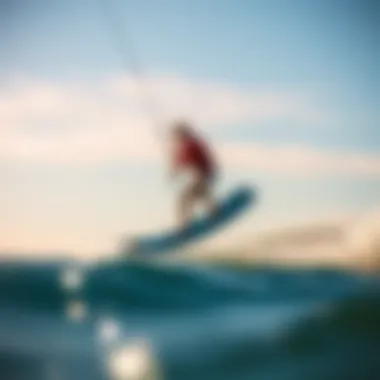
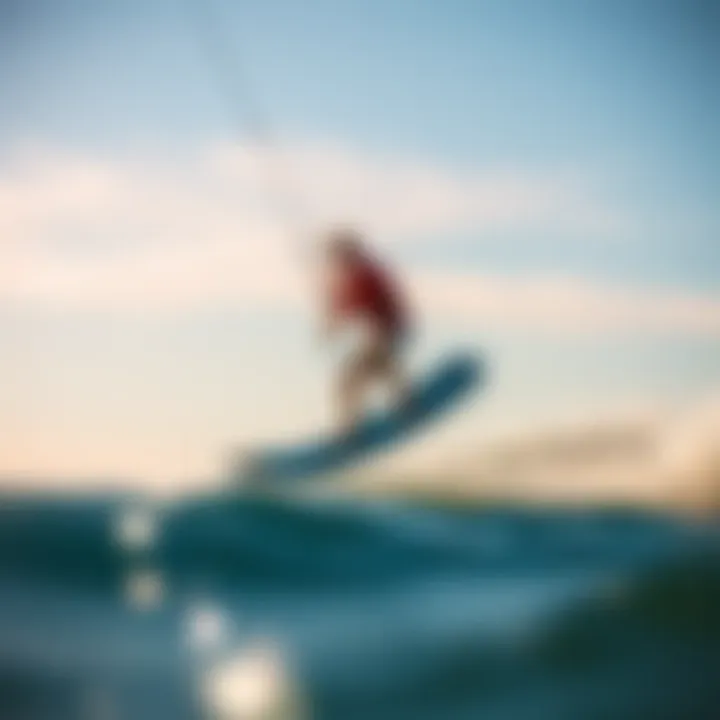
Intro
In the captivating world of kiteboarding, the demand for innovative equipment continuously evolves. Among these advancements, foil boards have emerged as a significant game changer for kiteboarders seeking new challenges and experiences on the water. For those new to this realm or seasoned riders considering a switch, understanding the various intricacies of foil boards can lead to empowered choices and enhanced riding experiences.
This guide will serve as your compass, exploring the many facets of foil boarding. From selecting the right gear to mastering essential skills, you’ll find comprehensive insights that cater to all levels of enthusiasm. Let’s dive in!
Gear Selection
Choosing the right gear is crucial for realizing your potential on the water. The connection between your kite, board, and other equipment directly impacts your performance and enjoyment.
Types of Kites
When it comes to kiting, not all kites are created equal. The choice of kite drastically changes how you experience foil boarding. Here are the main types you might consider:
- Delta Kites: Known for their stability and ease of use, making them suitable for beginners. These kites offer a friendly balance between power and control.
- Bow Kites: Known for their large surface area, these kites can produce impressive lift, making them ideal for foiling conditions. They allow riders to stay aloft even in light winds.
- C Kites: These provide excellent performance in strong winds. Though a bit more advanced, if you’re aiming for aggressive maneuvers, they'll be your best bet.
Choosing the correct kite is paramount. Ensure it suits not just your skill level but also the typical conditions of your favorite riding spots.
Choosing the Right Board
Selecting a board designed specifically for foiling can make a world of difference. Here, the components of the board come into play:
- Size: Foil boards typically range in size from around 4 to 6 feet. Smaller boards are often more maneuverable and responsive, while larger boards can offer better stability at lower speeds.
- Shape and Design: Look for a board with a flat bottom. A wider tail can help with planing, while a narrower nose can enhance your ability to carve.
- Weight and Material: Lightweight boards enhance your ability to lift off the water. Materials like carbon or advanced polymers provide durability while minimizing weight.
For both new and seasoned riders, investing time in researching the optimal board tailored to your individual preferences presents substantial gains.
Skill Development
Equipping yourself with the right gear is only half the battle. Mastering essential techniques and progressively building your skills define your kiteboarding journey.
Essential Techniques
For those just starting with foiling, here are some fundamental techniques to keep in mind:
- Body Positioning: Maintain a balanced stance. Bend your knees slightly, and lean forward a bit to stay connected with the board.
- Weight Distribution: Shift weight onto the back foot when taking off for better lift.
- Kite Control: Learn to fly the kite with precision, adjusting its angle to maintain speed and stability.
Progression Tips
- Practice in Different Conditions: Vary your riding conditions to adapt to various wind strengths and ocean states.
- Seek Expert Guidance: Consider taking lessons from qualified instructors. Their tips can accelerate your learning curve.
- Join Community Groups: Engaging with other kiteboarders can provide valuable insights and support. Websites like Reddit or kiteboarding forums are good places to start.
Culmination
Navigating the world of foil boards can seem daunting, but with careful consideration of gear and a commitment to skill development, you’ll find yourself soaring above the waves in no time. Whether you're a budding enthusiast or a seasoned kiteboarder, this guide aims to provide you with the knowledge needed to make informed decisions and elevate your kiteboarding experience.
Prolusion to Foil Boards
Foil boards have significantly reshaped the kiteboarding landscape, merging advanced technology with the thrill of gliding over water. For both seasoned kiteboarders and newcomers, understanding what foil boards offer and their rise in popularity can enhance your riding experience dramatically. The allure of foiling lies not only in the exciting ride but also in the unique challenges it presents, making it increasingly important for kiteboarding enthusiasts to comprehend their significance.
What is a Foil Board?
A foil board is a specially designed kiteboarding board that incorporates a hydrofoil, allowing riders to "fly" above the water's surface. This hydrofoil configuration consists of a mast, a front wing, and a rear wing, all of which work together to lift the rider out of the water when sufficient speed is achieved. It’s different from the traditional board as it minimizes drag, facilitating a smoother ride even in choppy conditions. Riders can experience a sensation akin to flying, gliding effortlessly while feeling every subtle movement of the ocean swell beneath them.
Diving further into the mechanics, the design of these boards promotes stability and performance. They often vary in size, shape, and materials, allowing riders to choose based on their skill level, riding style, and conditions. Whether you’re zipping along in flat water or tackling waves, a foil board enhances versatility and extends riding seasons.
The Rise of Foil Boards in Kiteboarding
In recent years, foil boards have exploded in popularity among kiteboarders, and for good reason. They open up a host of possibilities, pushing the boundaries of what is achievable on the water. Riders are finding themselves navigating through conditions that were once deemed less than ideal. The ability of foil boards to ride in lighter winds makes them immensely appealing. It’s an appealing prospect, particularly for novices eager to get out there without waiting for ideal conditions.
Moreover, the advent of lighter materials, such as carbon fiber, has played a significant role in the evolution of foil boarding. These advancements have led to more responsive and durable boards, appealing to both recreational and professional kiteboarders alike.
Interestingly, the community around kiteboarding has also embraced foiling as a way to tap into diverse experiences, leading to an increase in foiling events and gatherings. Enthusiasts share techniques, tips, and tricks, fostering a supportive environment that invites newcomers to learn and grow.
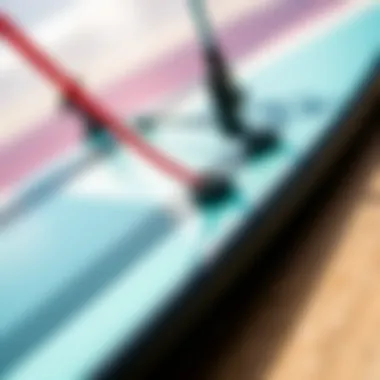
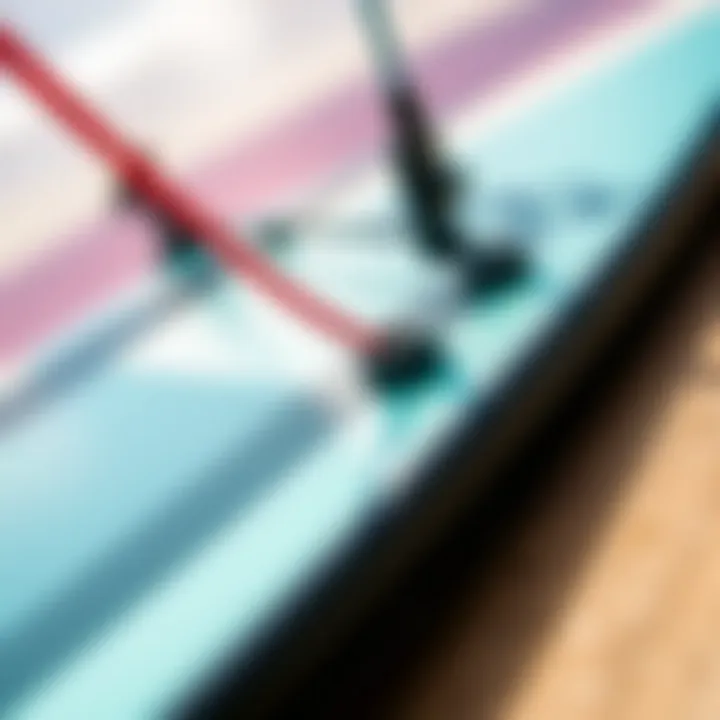
"Foil boarding isn't just about riding; it’s about connecting with the water and discovering what you’re truly capable of."
In summary, understanding foil boards is essential for anyone looking to dive into kiteboarding. With their unique design and growing presence within the kiteboarding community, foil boards open avenues for exciting new experiences on the water. As the sport continues to evolve, so too will the techniques, innovations, and thrills that foil boarding will bring to enthusiasts.
Understanding Foil Board Mechanics
In order to fully appreciate the nuances of kiteboarding with foil boards, it’s paramount to delve into the mechanics that underpin their performance. Understanding how these boards operate not only heightens the thrill of the ride but also informs the choices kiteboarders make when selecting gear. The essence of foiling revolves around harnessing hydrodynamics to achieve a ride that is both exhilarating and distinct from traditional kiteboarding methods. This section elucidates the workings of foil boards, breaking down the elements that contribute to their efficiency on water.
How Foiling Works
Foiling refers to the act of using a board attached to a foil, which lifts the rider above the water surface when in motion. This lift is achieved primarily through the shape and design of the foil itself, which operates on principles akin to those in aviation. As the board moves forward, water flows over the wings of the foil, creating pressure differences that generate lift. This allows the kiteboarder to glide seamlessly over the water, minimizing drag and enhancing speed.
The thrill of foiling is not just about rising above water but also about how it transforms the rider’s experience. By reducing contact with the water, boarders gain a smoother, more fluid ride, which can feel incredibly liberating. However, mastering this technique demands attention to balance and control, especially in varying wind conditions and water states.
Components of a Foil Board
Every part of a foil board has its own role to play in the overall performance, and understanding each component is crucial for both new and seasoned kiteboarders. Here, we break down the three core components: foils, boards, and fins.
Foils
Foils are arguably the heart of the system. They are designed to maximize lift while minimizing resistance. What sets foils apart is their ability to provide a unique gliding experience. A key characteristic of foils is their wing shape; well-crafted foils can create lift at lower speeds, making them incredibly versatile for different riding styles. For instance, a larger wing might be more stable at low speeds, making it a popular choice for beginners.
However, foils come with their own set of challenges. Riders often report that larger foils can feel cumbersome in high winds, which is why many experienced boarders opt for smaller, more agile foils during strong conditions. Each rider must then weigh the advantages of lift and stability against the versatility and responsiveness required for their specific riding style.
Boards
The board itself serves as the platform for the entire setup. The construction material often determines how responsive a board will be. A common material used is epoxy, known for its durability and lightweight nature. A crucial factor when choosing a board is its size and shape. For instance, wider boards provide added stability but may be less maneuverable in trick scenarios.
A notable characteristic of boards is their rocker profile, which influences how they glide over the water. Boards with more rocker cut through the surface tension better, providing a smoother ride. Nevertheless, too much rocker can compromise the speed, leading to a trade-off that every rider must navigate based on personal preferences and conditions.
Fins
Fins may seem like a small component, but they play a vital role in stability and control. Positioned at the bottom of the board, fins help in tracking straight and executing tight turns. A common feature of fins is that they can be swapped out depending on conditions; for instance, longer fins typically offer greater stability in choppy waters.
While some riders may appreciate the grip offered by smaller, more streamlined fins, they may sacrifice stability during jumps. Understanding the right fin setup can significantly affect a rider’s overall performance and should be tailored to individual needs and experiences.
Hydrodynamics and Performance
The interplay between hydrodynamics and performance is an essential theme when discussing foil boarding. Each component works not merely as a piece of equipment, but as part of a holistic system driven by the physics of water dynamics. The shape of the foil influences lift and drag, while the board’s materials contribute to agility and control. By comprehending these interactions, kiteboarding enthusiasts can better customize their gear setups for optimal performance.
Whether you’re gliding smoothly across glassy waters or jumping over waves, understanding foil board mechanics equips riders with the knowledge to optimize their performance and enhance their overall experience on the water. Knowledge is power, and in the world of kiteboarding, knowing what makes your foil board tick can spell the difference between a good ride and a great one.
Choosing the Right Foil Board
Selecting the appropriate foil board can feel like searching for a needle in a haystack, especially with the vast variety available in today’s market. Each kiteboarder has distinct needs and styles, making this decision a pivotal one. The right board not only enhances performance but also elevates the overall experience on the water. This section explores the essential elements you should consider when picking a foil board that suits your specific requirements, ensuring it aligns with your skills, body type, and riding style.
Factors to Consider
Skill Level
When it comes to skill level, understanding where you stand on the spectrum is crucial. Beginners often benefit from a board that offers stability and ease of use. In contrast, advanced kiteboarders might desire a more challenging board that allows them to push their limits.
- Key Characteristics: Most beginner-friendly boards are wider and feature a larger surface area for improved lift while getting up on the foil. Advanced riders, however, might opt for narrower boards which provide better speed and maneuverability at the cost of some stability.
- Advantages: A board suited to your skill level can make learning enjoyable and rewarding. If you’re just starting, a user-friendly board can help you progress faster, building your confidence. For the experienced rider, a performance board allows room for innovation and mastery of tricks.
Weight and Size
The dimensions of a foil board matter immensely and should not be overlooked. Your weight and height influence how a board performs on the water. Larger boards might support heavier riders, while smaller ones are designed for lighter individuals.
- Key Characteristics: A heavier rider may require a board with a larger surface area to generate enough lift, while lighter riders might find a smaller board maneuverable and agile.
- Disadvantages: Choosing the wrong size could lead to a frustrating experience. Excessively large boards can feel cumbersome, whereas a board too small may sink or become hard to control during sessions.
Riding Style
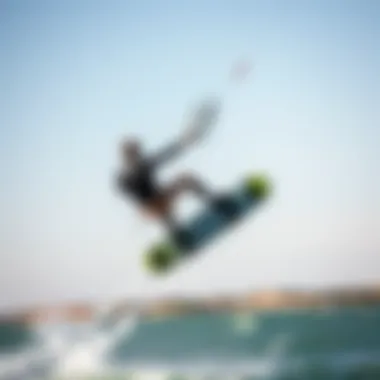
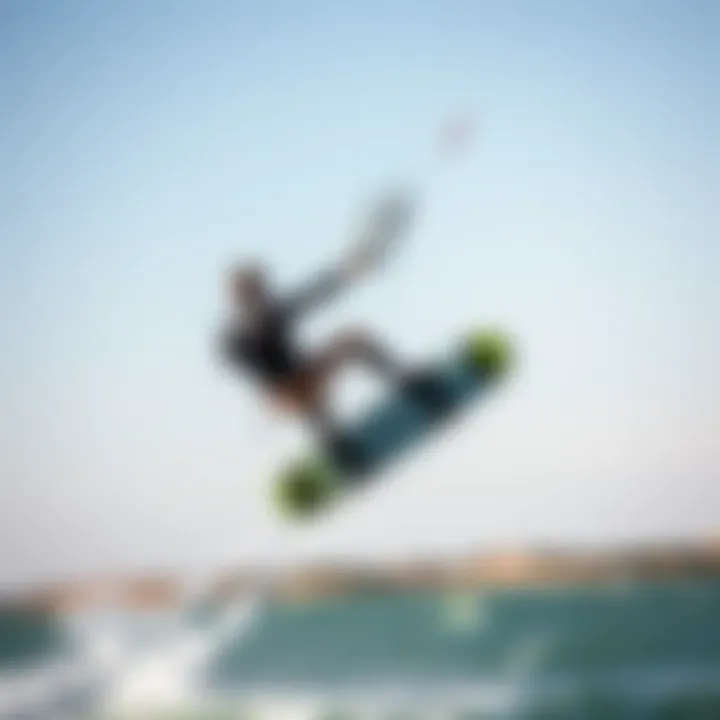
The style in which you ride—be it freestyle, wave riding, or cruising—shapes the type of foil board that suits your needs. Each style has its traits, making it essential to select a board designed for those conditions.
- Key Characteristics: Freestylers often lean towards boards that are flexible and lightweight, allowing for higher jumps and tricks. Wave riders may prefer boards that are responsive to changing conditions, while those who simply lounge on flat water might opt for stability and comfort.
- Advantages: Matching your board with your riding style enables you to perform optimally and enjoy the sport to its fullest. If you love to soar above the waves, the right board can empower you to explore new tricks with confidence while maintaining stability—all with ease.
Comparing Different Brands
With countless brands on the market, each boasting unique features and innovations, it can be tough to navigate your options. Brands like Slingshot, Naish, and Duotone have built strong reputations for quality and performance. Ensure to research customer reviews and look out for warranties to gauge a brand’s reliability. Choosing the right brand can significantly impact your overall satisfaction and performance.
Budget Considerations
Kiteboarding can be an expensive hobby, and foil boards are no exception. Setting a budget beforehand can help narrow down your choices. Consider that a higher price tag doesn’t always guarantee a better experience. It’s often wise to balance cost with quality, skill level, and type of riding you intend to do. Used boards can also be a good compromise for those just starting out or testing the waters with foiling.
Ultimately, the right foil board is one that feels like an extension of yourself, enhancing your moments on the water while aligning seamlessly with your goals as a kiteboarder.
"Choosing your foil board is a journey in itself. Take the time to find what resonates with you—after all, the right board makes all the difference between flying or floundering."
For additional information about brands and performance, visit resources such as kiteforum.com and check out forums on reddit.com for insights from fellow enthusiasts.
Foil Board Locations
Finding the right spot to practice foil boarding can make or break your experience. Locations matter not just for the fun factor, but for safety and skill development too. With a proper spot, the learning curve feels much less steep and you can build confidence quicker. Understanding where to go is crucial for kiteboarding enthusiasts seeking to enhance their skills and enjoyment on the water.
Finding Foil Boards Near You
When it comes to getting into foil boarding, location is key. Look around and you might find specialized shops that sell or rent out foil boards in your local area. Online platforms like Facebook Marketplace or Kite Forum can also provide options directly from fellow enthusiasts. Don’t forget to check with local kiteboarding schools or clubs—they often have equipment available or can steer you in the right direction.
Exploring forums such as Reddit can connect you to fellow boarders who may have local knowledge of the best places to find boards. If you’re lucky, you might even find someone willing to let you try out their gear before committing to a purchase.
Top Kiteboarding Spots for Foiling
Kiteboarding and foiling can be enjoyed in various environments. Here are some of the most popular spots for those looking to get into foil boarding:
Coastal Locations
Coastal areas offer some of the best conditions for foil boarding. The key characteristic here is the consistent wind patterns found near the ocean. For instance, having large stretches of open water means that kiteboarders can practice their skills without worrying too much about sudden obstacles. One major benefit of coastal locations is the ability to catch waves, making foiling a thrilling experience. However, these places might be crowded, especially on weekends, so waiting in line to get your turn can be a downside.
Lakes and Rivers
Lakes and rivers provide a different backdrop for foil boarding. The calm waters often found in freshwater locations can be ideal for beginners who need time to practice balance without the waves throwing them off. Lakes also generally have less traffic than coastal areas. However, depending on the river's current, stability might be a challenge, especially in spots that have fast flows or obstacles like rocks. Being aware of possible hazards is essential before heading out.
Waves vs. Flat Water
The choice between riding on waves or flat water impacts the kind of experience one has while foil boarding. Riding waves can be exhilarating and offers the chance for jumps and tricks to be performed. The fluid motion of the waves provides a unique thrill and is often preferred by more advanced kiteboarders looking for a challenge.
On the flip side, flat water is paramount for beginners who need to refine their control; it presents fewer challenges. Learning here allows one to build confidence in their skills without the unpredictability of the ocean. However, flat-water spots may lack the excitement of waves, making it crucial to weigh personal preferences when deciding.
"Choosing the right location to foil board is as important as selecting the board itself. Your surroundings significantly affect skill enhancement and enjoyment!"
With this knowledge of locations, you can greatly enhance your kiteboarding experience. The right place can foster progression, safety, and fun, promoting a deep connection with the slowly evolving art of foiling.
Safety Considerations in Foil Boarding
Kiteboarding, especially when combined with foil boarding, opens avenues for exhilarating water experiences. However, diving into this thrilling sport isn’t without its hazards. Understanding safety considerations is paramount. Misjudgments and a lack of precautions can lead to severe injuries or accidents. Ultimately, prioritizing safety enhances not only individual enjoyment but also fosters a responsible kiteboarding culture among enthusiasts.
Essential Safety Gear
When hitting the water, having the right safety gear can be a game changer, quite literally. Here’s a closer look at essential gear that can aid in reducing risks while enjoying your slice of heaven on a foil board:
- Helmet: A properly fitted helmet is your first line of defense against head injuries. Falls and collisions can happen in the blink of an eye, and ensuring your noggin is well protected is crucial.
- Impact Vest: This provides cushioning during falls and offers an added layer of safety. An impact vest won’t just shield you but can also provide buoyancy, making recovering from spills easier.
- Leash System: Securely attaching yourself to the board with a leash system ensures that you don’t lose your equipment in the water. A quality leash can prevent entanglement hazards and simplify board retrieval after a fall.
- Personal Flotation Device (PFD): Even if you consider yourself a strong swimmer, a well-fitted PFD can be life-saving, especially when navigating open waters or challenging conditions. It keeps you afloat while you gather yourself.
- Cutting tool: A small, accessible knife is vital in emergencies. Should your lines get tangled, a quick snip can be the difference between a minor inconvenience and a serious incident.
Understanding Local Regulations


Each geographical area has its own set of guidelines and rules concerning kiteboarding, particularly when foils come into play. Familiarizing oneself with these regulations is indispensable for safety and environmental respect:
- Check Local Conditions: Weather patterns, tides, and wind conditions can affect safety. Always check local forecasts and warnings before heading out.
- Floating Zones and No-Go Areas: Some locations have designated zones to minimize risks to wildlife, particularly in sensitive areas such as lagoons or marine parks. Respecting these zones protects both the environment and your own safety.
- Regulatory Bodies: Local kiteboarding associations often provide resources on best practices and safety measures. Websites like austraila.gov or kiteboarding.org can be invaluable.
- Permits and Insurance: Depending on the location, you might need permits to kiteboard. Some areas also require liability insurance. Clarifying these points will not only keep you lawful but also offer peace of mind whilst foiling.
"Safety isn’t just about gear. It’s also inherently about knowledge and preparation. A well-prepared kiteboarder is a safer kiteboarder."
Ultimately, embracing safety gear and understanding local regulations are important steps every kiteboarding enthusiast should take. This awareness solidifies a responsible approach to enjoying the sport while minimizing the inherent risks it carries.
Environmental Impact and Responsibility
The discussion surrounding environmental impact and responsibility in the realm of kiteboarding is more crucial now than ever. As the sport continues to expand its reach across coastlines and freshwater bodies, it becomes paramount for kiteboarding enthusiasts to recognize the importance of sustainable practices. By understanding how our hobbies influence the environment, we can make more informed choices that not only preserve our passion but also protect the ecosystems we cherish. To put it simply: a sustainable approach does not just benefit the environment; it enriches our experience as kiteboarders.
Sustainable Kiteboarding Practices
When it comes to kiteboarding sustainably, a few practices come to mind. Here are some essential ways to keep our oceans healthy:
- Choose Eco-Friendly Gear: Not all equipment is created equal. Some manufacturers are focusing on reducing environmental impact by using recycled materials and processes that are less harmful to nature. Consider brands like North Kiteboarding or Duotone, which are making strides in this direction.
- Waste Management: Whether at the beach or on the water, it’s vital to keep the environment clean. Carry a bag for trash and aim to leave the area better than you found it. Little actions build up to significant impacts.
- Educate Fellow Riders: Share knowledge about the importance of environmental responsibility with your friends and within your local kiteboarding community. Sometimes a simple conversation can spark a change in habits.
Taking these steps not only lessens negative effects but can also enhance the kiteboarding experience by creating a cleaner, more enjoyable environment.
Protecting Natural Habitats
The oceans and rivers we enjoy are home to diverse marine life, and kiteboarding can sometimes disrupt these natural habitats. To lessen this impact, consider the following:
- Avoid Fragile Areas: Steer clear of breeding grounds or areas that are home to sensitive species. Consulting local guidelines or engaging with community groups can help identify these regions.
- Know the Ecosystem: Understanding the local fauna can aid in making choices that benefit both kiteboarders and wildlife. Are there particular seasons when wildlife is breeding or migrating? Knowing this helps us avoid harming habitats during critical times.
- Support Conservation Initiatives: Many organizations are dedicated to preserving marine life and coastal areas. Contributions to such initiatives or participating in local clean-up events can make a tangible difference.
As stewards of the ocean and the rivers, kiteboarders play a vital role in safeguarding these environments for future generations.
"In every action, there lies a choice — and our choices today will define the oceans of tomorrow."
Embracing these environmental considerations not only aligns with responsible kiteboarding but fosters a deeper appreciation for the nature we interact with while we ride the waves.
Upcoming Trends in Foil Boarding
The landscape of foil boarding is not stagnant; it’s constantly evolving, shaped by new ideas and advancements. Understanding these trends is essential for enthusiasts looking to stay ahead of the curve. Keeping an eye on upcoming changes can affect everything from board performance to community engagement. With the right insight, kiteboarders can make informed choices about gear, techniques, and even the events they participate in.
Innovations in Design
When it comes to foil board design, innovation is the name of the game. Manufacturers are continuously experimenting with different materials and shapes to boost performance. Recent trends have seen the rise of lightweight composites, allowing riders to enjoy increased agility without sacrificing stability. For instance, boards that use carbon fiber technology are becoming more prevalent. These boards offer superior strength and flexibility, making it easier for riders to carve through the water smoothly.
Another notable design trend is the introduction of adjustable foils. This feature allows riders to fine-tune their setup according to varying wind conditions, maximizing the performance potential of their gear. Riders can now adjust the angle of the front wing, which in turn, modifies lift and drag. This is hugely beneficial for those looking to switch between freestyle and racing styles easily.
Additionally, hydrodynamic shapes are getting a lot of attention, with boards featuring contours designed to minimize drag and maximize lift. These designs are tailored for top-tier performance, ensuring that riders can reach faster speeds while maintaining control.
"The best way to predict the future is to create it." - Peter Drucker
The Future of Foiling Events
As the popularity of foil boarding surges, events tailored specifically for foiling are cropping up everywhere. These events offer a platform for riders to showcase their skills in both competitive and fun environments. One notable trend is the rise of foil-specific competitions, which emphasize various styles such as freestyle, racing, and endurance foiling. This helps integrate foil boarding into the broader kiteboarding community while also attracting new participants.
Event organizers are increasingly focusing on sustainability, seeking eco-friendly venues and employing practices that minimize environmental impact. Many kiteboarding competitions now incorporate beach clean-up days or pledge to donate a portion of proceeds to ocean conservation. This shift not only emphasizes responsibility but also fosters a community that values protecting the natural habitats where we foil.
Moreover, virtual competitions are making waves. Used mainly during the pandemic, online challenges have found a niche appeal among riders who want to connect while staying safe. Competitors submit videos of their rides, allowing participants from around the globe to compete without the need for travel. This trend might just be a glimpse into the future of competitive foil boarding, making it accessible to a wider audience.
As foiling continues to gain traction in the kiteboarding world, these innovative designs and forward-thinking events will play a pivotal role in shaping how the sport evolves. Staying informed about these trends ensures that riders can fully enjoy what foil boarding has to offer, both in terms of equipment and community engagement.
Finale
Drawing the curtain on this exploration of foil boards, it’s clear that understanding these innovative tools is vital for kiteboarding enthusiasts. The insights shared throughout this guide underscore several key elements that anyone looking to delve into or enhance their foiling experience should consider.
Firstly, the mechanics of foil boards remain at the core of enjoyable and safe riding. Recognizing how different components interact can significantly influence your performance on the water. Whether it’s grasping the hydrodynamics or comparing different brands, knowledge equips riders to make better choices that align with their specific needs and riding style.
Moreover, the environmental aspect of kiteboarding cannot be overlooked. As enthusiasts immerse themselves in this thrilling sport, it becomes increasingly important to practice sustainable riding. Not only does this preserve the natural beauty of our waters, but it also ensures that future generations can enjoy the thrill of foil boarding.
"The more you know, the better you ride" - a simple mantra that rings true in the foiling community.
Finally, as the sport continues to evolve, staying abreast of upcoming trends and innovations can enhance not just performance but also enjoyment and safety on the water. Keeping an eye on new technologies can mean the difference between slipping through the waves effortlessly and wrestling with instability.















